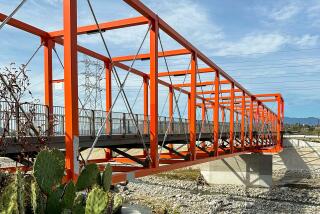Greene Span
- Share via
Architects Charles and Henry Greene were known for their residential Craftsman aesthetics, not their public works prowess. Their 1906 Oaklawn Bridge in South Pasadena, though currently in a sorry state, is “wonderful precisely because it’s out of character,” says Edward Bosley, author of the upcoming book “Greene & Greene” (Phaidon Press, June).
With help from a $594,000 federal grant, the city of South Pasadena plans to begin restoring the one-lane concrete span later this summer. The brothers originally designed the bridge off Fair Oaks Avenue as a gateway to the Oaklawn housing development. It initially carried traffic over two railway lines, a road and the fabled California Cycleway bike path. But it was restricted to pedestrian traffic in the ‘50s and will remain so after the renovation. “With today’s vehicles, you couldn’t get two-way traffic across it,” says South Pasadena Public Works Director Jim Van Winkle. Trains will once again run beneath it when the planned 13.7-mile light-rail line connecting Chinatown to Pasadena is completed.
Bosley, who is also director of the Greenes’ 1908 Gamble House in Pasadena, says that when cracks appeared in the concrete soon after the bridge was built, the brothers conducted an 18-ton stress test. They loaded the 340-foot-long bridge with sandbags, automobiles, donkeys, horses, even people. It showed a 3/16-inch sag, says Bosley. Though it was structurally acceptable, railway officials “still thought it a perceived risk” and insisted that the Greenes add an 85-foot-high central support pier the architects always felt compromised the graceful integrity of the arch.
The bridge will be retrofitted to withstand earthquakes, its cracked concrete filled, its graffiti and unsightly central pier removed. Its biggest stress today will probably be a portly South Pasadenan towing home too many groceries from the bus stop.






